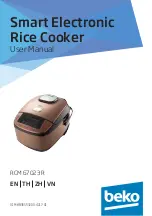
7
8
Cleaning Instructions
This appliance should be cleaned after every use.
1.
Unplug the Automatic Rice Cooker when not in use or
before cleaning.
Never immerse Heating Body in water
or any other liquid!
Allow the Automatic Rice Cooker to
cool completely before cleaning.
2.
Do not use abrasive cleaners or scouring pads or steel
wool to clean the Automatic Rice Cooker.
3.
Do not use bleach, vinegar, or other harsh chemicals to
clean the Automatic Rice Cooker.
4.
To clean the Heating Body, lightly wipe the exterior with a
damp cloth or sponge.
Do not immerse Heating Body
into water or any other liquid!
Dry thoroughly with a soft
cloth.
5.
To clean the Inner Pot, remove from the Rice Cooker and
fill with hot water from the tap. Let it sit for a while and then
wash with hot, soapy water. Rinse thoroughly and dry.
6.
The Measuring Cup and Ladle can be washed in warm,
soapy water.
They are not dishwasher safe.
7.
Wipe down the inside of the Lid if necessary with a clean
damp cloth or sponge.
8.
Make sure that grains of rice do not stick to the Heating
Element in the bottom of the Heating Body. If this occurs,
remove immediately. If grains of rice are cooking onto the
Heating Plate, a non-abrasive pad can be used to remove
it. Polish the area for good contact between the Heating
Plate and the bottom of the Inner Pot.
9. Heating Body.
Lightly wipe the exterior with a damp cloth.
DO NOT IMMERSE THE HEATING BODY IN WATER
OR ANY OTHER LIQUID!
Dry thoroughly with a soft cloth.
10. Glass Lid, Measuring Cup, Ladle.
Wash in warm, soapy
water. Rinse thoroughly and dry.
CAUTION: Handle the Glass Lid with extreme care, as
it may become slippery when wet.
11.
There are no user serviceable parts inside this appliance.
Do not attempt to repair this appliance yourself, as you
could render it dangerous to use.
Why Rice & Whole Grains?
Grains (including rice) are finally getting the attention they deserve
as they move into the nutritional spotlight. The new USDA dietary
recommendations highlight grains and legumes as an essential part
of a healthy, whole foods diet. With their impressive fiber, complex
carbohydrates and protein profiles, they are, without a doubt, some
of Mother Nature’s most perfect foods.
Grains are the edible portion of cereal plants. The grain or kernel is
technically a complete fruit and houses most of its nutritional value.
In addition to their high fiber content, grains are an excellent source
of B vitamins and many minerals, including magnesium, iron, zinc,
potassium and selenium. The germ oils found in the germ layers of
whole grains contain vitamin E, an important antioxidant.
Whole grains that are best served alone or as complements to main
dishes include: wheat, rice, rye, quinoa, barley and oats just to
name a few. Breads, crackers, pastas and cereals are products
made from grains that have been ground into flours. Only flours
labeled as whole grain contain the bran and germ portion of the
grain. If the label just lists flour even if the flour is labeled as enriched
or wheat flour, the nutrient-rich bran and germ portion of the grain
have usually been removed.


































